Jian Liu
refer to the report for detailed contributions
Every Step Evolves: Scaling Reinforcement Learning for Trillion-Scale Thinking Model
Oct 21, 2025Abstract:We present Ring-1T, the first open-source, state-of-the-art thinking model with a trillion-scale parameter. It features 1 trillion total parameters and activates approximately 50 billion per token. Training such models at a trillion-parameter scale introduces unprecedented challenges, including train-inference misalignment, inefficiencies in rollout processing, and bottlenecks in the RL system. To address these, we pioneer three interconnected innovations: (1) IcePop stabilizes RL training via token-level discrepancy masking and clipping, resolving instability from training-inference mismatches; (2) C3PO++ improves resource utilization for long rollouts under a token budget by dynamically partitioning them, thereby obtaining high time efficiency; and (3) ASystem, a high-performance RL framework designed to overcome the systemic bottlenecks that impede trillion-parameter model training. Ring-1T delivers breakthrough results across critical benchmarks: 93.4 on AIME-2025, 86.72 on HMMT-2025, 2088 on CodeForces, and 55.94 on ARC-AGI-v1. Notably, it attains a silver medal-level result on the IMO-2025, underscoring its exceptional reasoning capabilities. By releasing the complete 1T parameter MoE model to the community, we provide the research community with direct access to cutting-edge reasoning capabilities. This contribution marks a significant milestone in democratizing large-scale reasoning intelligence and establishes a new baseline for open-source model performance.
GeoPurify: A Data-Efficient Geometric Distillation Framework for Open-Vocabulary 3D Segmentation
Oct 02, 2025
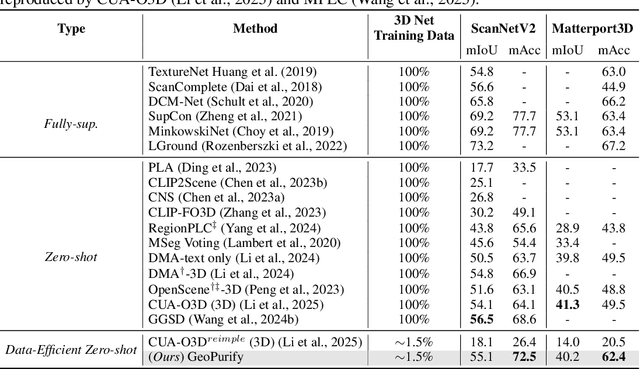
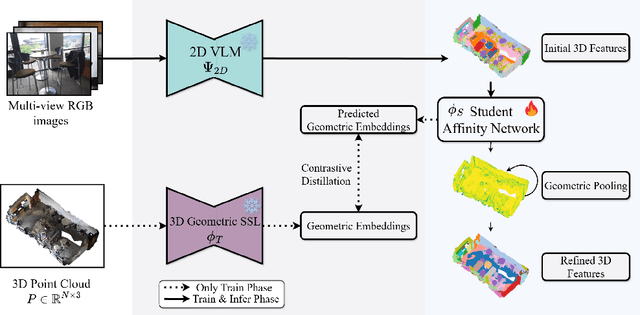

Abstract:Recent attempts to transfer features from 2D Vision-Language Models (VLMs) to 3D semantic segmentation expose a persistent trade-off. Directly projecting 2D features into 3D yields noisy and fragmented predictions, whereas enforcing geometric coherence necessitates costly training pipelines and large-scale annotated 3D data. We argue that this limitation stems from the dominant segmentation-and-matching paradigm, which fails to reconcile 2D semantics with 3D geometric structure. The geometric cues are not eliminated during the 2D-to-3D transfer but remain latent within the noisy and view-aggregated features. To exploit this property, we propose GeoPurify that applies a small Student Affinity Network to purify 2D VLM-generated 3D point features using geometric priors distilled from a 3D self-supervised teacher model. During inference, we devise a Geometry-Guided Pooling module to further denoise the point cloud and ensure the semantic and structural consistency. Benefiting from latent geometric information and the learned affinity network, GeoPurify effectively mitigates the trade-off and achieves superior data efficiency. Extensive experiments on major 3D benchmarks demonstrate that GeoPurify achieves or surpasses state-of-the-art performance while utilizing only about 1.5% of the training data. Our codes and checkpoints are available at [https://github.com/tj12323/GeoPurify](https://github.com/tj12323/GeoPurify).
Hunyuan3D Studio: End-to-End AI Pipeline for Game-Ready 3D Asset Generation
Sep 16, 2025



Abstract:The creation of high-quality 3D assets, a cornerstone of modern game development, has long been characterized by labor-intensive and specialized workflows. This paper presents Hunyuan3D Studio, an end-to-end AI-powered content creation platform designed to revolutionize the game production pipeline by automating and streamlining the generation of game-ready 3D assets. At its core, Hunyuan3D Studio integrates a suite of advanced neural modules (such as Part-level 3D Generation, Polygon Generation, Semantic UV, etc.) into a cohesive and user-friendly system. This unified framework allows for the rapid transformation of a single concept image or textual description into a fully-realized, production-quality 3D model complete with optimized geometry and high-fidelity PBR textures. We demonstrate that assets generated by Hunyuan3D Studio are not only visually compelling but also adhere to the stringent technical requirements of contemporary game engines, significantly reducing iteration time and lowering the barrier to entry for 3D content creation. By providing a seamless bridge from creative intent to technical asset, Hunyuan3D Studio represents a significant leap forward for AI-assisted workflows in game development and interactive media.
SoccerNet 2025 Challenges Results
Aug 26, 2025Abstract:The SoccerNet 2025 Challenges mark the fifth annual edition of the SoccerNet open benchmarking effort, dedicated to advancing computer vision research in football video understanding. This year's challenges span four vision-based tasks: (1) Team Ball Action Spotting, focused on detecting ball-related actions in football broadcasts and assigning actions to teams; (2) Monocular Depth Estimation, targeting the recovery of scene geometry from single-camera broadcast clips through relative depth estimation for each pixel; (3) Multi-View Foul Recognition, requiring the analysis of multiple synchronized camera views to classify fouls and their severity; and (4) Game State Reconstruction, aimed at localizing and identifying all players from a broadcast video to reconstruct the game state on a 2D top-view of the field. Across all tasks, participants were provided with large-scale annotated datasets, unified evaluation protocols, and strong baselines as starting points. This report presents the results of each challenge, highlights the top-performing solutions, and provides insights into the progress made by the community. The SoccerNet Challenges continue to serve as a driving force for reproducible, open research at the intersection of computer vision, artificial intelligence, and sports. Detailed information about the tasks, challenges, and leaderboards can be found at https://www.soccer-net.org, with baselines and development kits available at https://github.com/SoccerNet.
Auto-Connect: Connectivity-Preserving RigFormer with Direct Preference Optimization
Jun 13, 2025Abstract:We introduce Auto-Connect, a novel approach for automatic rigging that explicitly preserves skeletal connectivity through a connectivity-preserving tokenization scheme. Unlike previous methods that predict bone positions represented as two joints or first predict points before determining connectivity, our method employs special tokens to define endpoints for each joint's children and for each hierarchical layer, effectively automating connectivity relationships. This approach significantly enhances topological accuracy by integrating connectivity information directly into the prediction framework. To further guarantee high-quality topology, we implement a topology-aware reward function that quantifies topological correctness, which is then utilized in a post-training phase through reward-guided Direct Preference Optimization. Additionally, we incorporate implicit geodesic features for latent top-k bone selection, which substantially improves skinning quality. By leveraging geodesic distance information within the model's latent space, our approach intelligently determines the most influential bones for each vertex, effectively mitigating common skinning artifacts. This combination of connectivity-preserving tokenization, reward-guided fine-tuning, and geodesic-aware bone selection enables our model to consistently generate more anatomically plausible skeletal structures with superior deformation properties.
Occlusion-Aware 3D Hand-Object Pose Estimation with Masked AutoEncoders
Jun 12, 2025Abstract:Hand-object pose estimation from monocular RGB images remains a significant challenge mainly due to the severe occlusions inherent in hand-object interactions. Existing methods do not sufficiently explore global structural perception and reasoning, which limits their effectiveness in handling occluded hand-object interactions. To address this challenge, we propose an occlusion-aware hand-object pose estimation method based on masked autoencoders, termed as HOMAE. Specifically, we propose a target-focused masking strategy that imposes structured occlusion on regions of hand-object interaction, encouraging the model to learn context-aware features and reason about the occluded structures. We further integrate multi-scale features extracted from the decoder to predict a signed distance field (SDF), capturing both global context and fine-grained geometry. To enhance geometric perception, we combine the implicit SDF with an explicit point cloud derived from the SDF, leveraging the complementary strengths of both representations. This fusion enables more robust handling of occluded regions by combining the global context from the SDF with the precise local geometry provided by the point cloud. Extensive experiments on challenging DexYCB and HO3Dv2 benchmarks demonstrate that HOMAE achieves state-of-the-art performance in hand-object pose estimation. We will release our code and model.
Designing Pin-pression Gripper and Learning its Dexterous Grasping with Online In-hand Adjustment
May 25, 2025Abstract:We introduce a novel design of parallel-jaw grippers drawing inspiration from pin-pression toys. The proposed pin-pression gripper features a distinctive mechanism in which each finger integrates a 2D array of pins capable of independent extension and retraction. This unique design allows the gripper to instantaneously customize its finger's shape to conform to the object being grasped by dynamically adjusting the extension/retraction of the pins. In addition, the gripper excels in in-hand re-orientation of objects for enhanced grasping stability again via dynamically adjusting the pins. To learn the dynamic grasping skills of pin-pression grippers, we devise a dedicated reinforcement learning algorithm with careful designs of state representation and reward shaping. To achieve a more efficient grasp-while-lift grasping mode, we propose a curriculum learning scheme. Extensive evaluations demonstrate that our design, together with the learned skills, leads to highly flexible and robust grasping with much stronger generality to unseen objects than alternatives. We also highlight encouraging physical results of sim-to-real transfer on a physically manufactured pin-pression gripper, demonstrating the practical significance of our novel gripper design and grasping skill. Demonstration videos for this paper are available at https://github.com/siggraph-pin-pression-gripper/pin-pression-gripper-video.
Mesh-RFT: Enhancing Mesh Generation via Fine-grained Reinforcement Fine-Tuning
May 22, 2025
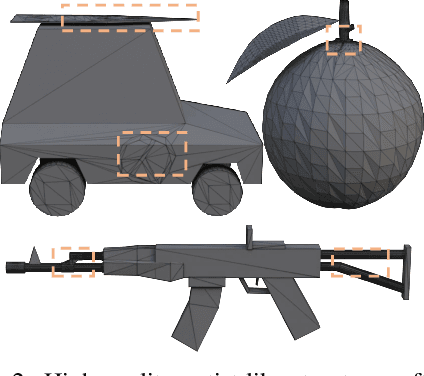
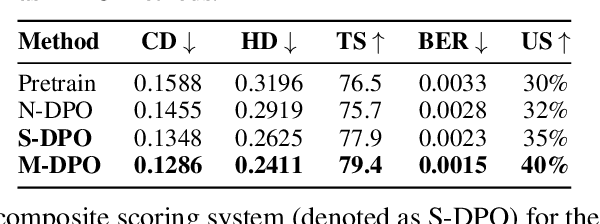
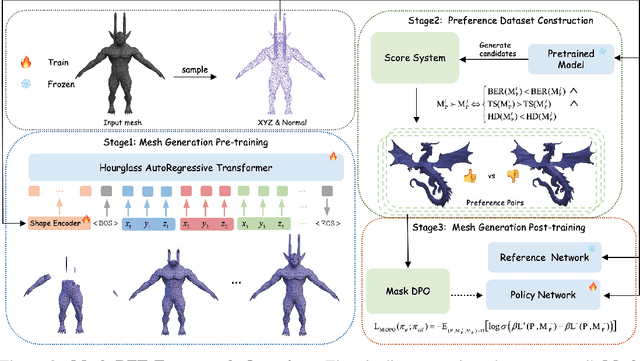
Abstract:Existing pretrained models for 3D mesh generation often suffer from data biases and produce low-quality results, while global reinforcement learning (RL) methods rely on object-level rewards that struggle to capture local structure details. To address these challenges, we present \textbf{Mesh-RFT}, a novel fine-grained reinforcement fine-tuning framework that employs Masked Direct Preference Optimization (M-DPO) to enable localized refinement via quality-aware face masking. To facilitate efficient quality evaluation, we introduce an objective topology-aware scoring system to evaluate geometric integrity and topological regularity at both object and face levels through two metrics: Boundary Edge Ratio (BER) and Topology Score (TS). By integrating these metrics into a fine-grained RL strategy, Mesh-RFT becomes the first method to optimize mesh quality at the granularity of individual faces, resolving localized errors while preserving global coherence. Experiment results show that our M-DPO approach reduces Hausdorff Distance (HD) by 24.6\% and improves Topology Score (TS) by 3.8\% over pre-trained models, while outperforming global DPO methods with a 17.4\% HD reduction and 4.9\% TS gain. These results demonstrate Mesh-RFT's ability to improve geometric integrity and topological regularity, achieving new state-of-the-art performance in production-ready mesh generation. Project Page: \href{https://hitcslj.github.io/mesh-rft/}{this https URL}.
FreeMesh: Boosting Mesh Generation with Coordinates Merging
May 19, 2025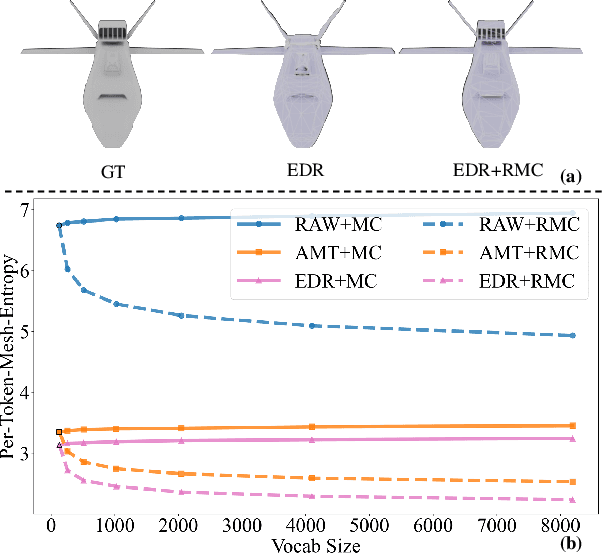
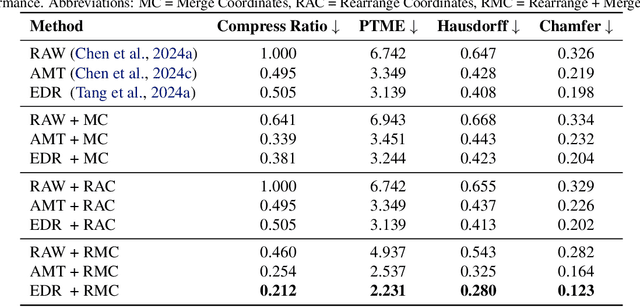
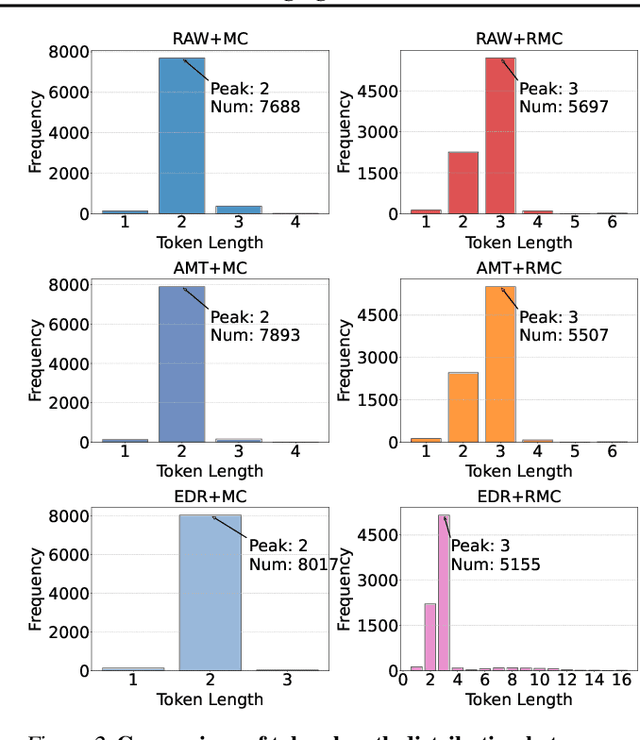

Abstract:The next-coordinate prediction paradigm has emerged as the de facto standard in current auto-regressive mesh generation methods. Despite their effectiveness, there is no efficient measurement for the various tokenizers that serialize meshes into sequences. In this paper, we introduce a new metric Per-Token-Mesh-Entropy (PTME) to evaluate the existing mesh tokenizers theoretically without any training. Building upon PTME, we propose a plug-and-play tokenization technique called coordinate merging. It further improves the compression ratios of existing tokenizers by rearranging and merging the most frequent patterns of coordinates. Through experiments on various tokenization methods like MeshXL, MeshAnything V2, and Edgerunner, we further validate the performance of our method. We hope that the proposed PTME and coordinate merging can enhance the existing mesh tokenizers and guide the further development of native mesh generation.
ForensicHub: A Unified Benchmark & Codebase for All-Domain Fake Image Detection and Localization
May 16, 2025Abstract:The field of Fake Image Detection and Localization (FIDL) is highly fragmented, encompassing four domains: deepfake detection (Deepfake), image manipulation detection and localization (IMDL), artificial intelligence-generated image detection (AIGC), and document image manipulation localization (Doc). Although individual benchmarks exist in some domains, a unified benchmark for all domains in FIDL remains blank. The absence of a unified benchmark results in significant domain silos, where each domain independently constructs its datasets, models, and evaluation protocols without interoperability, preventing cross-domain comparisons and hindering the development of the entire FIDL field. To close the domain silo barrier, we propose ForensicHub, the first unified benchmark & codebase for all-domain fake image detection and localization. Considering drastic variations on dataset, model, and evaluation configurations across all domains, as well as the scarcity of open-sourced baseline models and the lack of individual benchmarks in some domains, ForensicHub: i) proposes a modular and configuration-driven architecture that decomposes forensic pipelines into interchangeable components across datasets, transforms, models, and evaluators, allowing flexible composition across all domains; ii) fully implements 10 baseline models, 6 backbones, 2 new benchmarks for AIGC and Doc, and integrates 2 existing benchmarks of DeepfakeBench and IMDLBenCo through an adapter-based design; iii) conducts indepth analysis based on the ForensicHub, offering 8 key actionable insights into FIDL model architecture, dataset characteristics, and evaluation standards. ForensicHub represents a significant leap forward in breaking the domain silos in the FIDL field and inspiring future breakthroughs.
 Add to Chrome
Add to Chrome Add to Firefox
Add to Firefox Add to Edge
Add to Edge